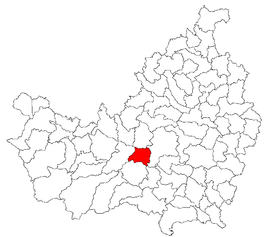Florești, Cluj
Florești (Hungarian: Szászfenes; German: Deutsch Branndorf) is a commune in Cluj County, Transylvania, Romania. It is composed of three villages: Florești, Luna de Sus (Magyarlóna) and Tăuți (Kolozstótfalu) and is part of the Cluj-Napoca metropolitan area, being located less than 8 km west of Cluj-Napoca on DN1.
Florești | |
|---|---|
 Location in Cluj County | |
 Florești Location in Romania | |
| Coordinates: 46°44′51″N 23°29′27″E | |
| Country | |
| County | Cluj |
| Subdivisions | Florești, Luna de Sus, Tăuți |
| Government | |
| • Mayor | Horia-Petru Șulea[1] (PNL) |
| Area | 61 km2 (24 sq mi) |
| Population (2011)[2] | 22,813 |
| • Density | 370/km2 (970/sq mi) |
| Time zone | EET/EEST (UTC+2/+3) |
| Postal code | 407280 |
| Area code | +40 x64 |
| Vehicle reg. | CJ |
Benefiting from its proximity to Cluj-Napoca, the commune has seen a substantial development since the early 2000s, including a threefold increase in population, mainly due to several new residential developments. It was the most populous commune in Romania recorded at the 2011 census.[3]
Geography
Floreşti is located on the river Someșul Mic, in the centre of Cluj County, less than 8 km from the county capital, Cluj-Napoca, and 7 km from the commune of Gilău, on the Romanian National Road DN1.
Demographics
According to the 2011 census, the commune has 22,813 inhabitants, meaning that a 300% increase was recorded since the previous census of 2002 when 7,470 inhabitants were recorded. In terms of ethnic structure, the commune's population is composed of 75.2% Romanians, 14.4% Hungarians and 4.9% Roma.
Historical population
The historical population of the entire commune as recorded by the official censuses, and projected to the present-day administrative unit, was as follows:[4][5][6]
| Year | Total | Romanians | Hungarians | Roma |
|---|---|---|---|---|
| 1850 | 3,009 | 1,549 | 1,197 | 227 |
| 1880 | 3,655 | 1,761 | 1,546 | n/a |
| 1890 | 4,058 | 2,032 | 1,755 | n/a |
| 1900 | 4,435 | 2,260 | 1,995 | n/a |
| 1910 | 4,702 | 2,420 | 2,044 | n/a |
| 1920 | 4,956 | 2,567 | 2,251 | n/a |
| 1930 | 5,280 | 2,706 | 2,194 | 327 |
| 1941 | 6,086 | 2,612 | 3,364 | 95 |
| 1956 | 5,586 | 3,060 | 2,231 | 289 |
| 1966 | 6,012 | 3,248 | 2,399 | 369 |
| 1977 | 6,865 | 3,668 | 2,385 | 809 |
| 1992 | 6,088 | 3,439 | 2,020 | 626 |
| 2002 | 7,470 | 4,516 | 2,057 | 888 |
| 2011 | 22,813 | 17,154 | 3,276 | 1,116 |
Images
 The fortified Roman Catholic church
The fortified Roman Catholic church
References
- "Results of the 2016 local elections". Central Electoral Bureau. Retrieved 6 April 2020.
- "Populaţia stabilă pe judeţe, municipii, oraşe şi localităti componenete la RPL_2011" (in Romanian). National Institute of Statistics. Retrieved 4 February 2014.
- "Floreştiul, comuna cu cea mai mare populaţie din România". CityNews. 2012-11-02. Retrieved 2012-02-29.
- Tab8. Populaţia stabilă după etnie – judeţe, municipii, oraşe, comune, 2011 census results, Institutul Național de Statistică, accessed 17 February 2020.
- Varga E. Árpád: Erdély etnikai és felekezeti statisztikája (1850-1992) Retrieved 2007-05-10
- Transindex Recensamânt 2002 website Archived 2012-02-09 at the Wayback Machine Retrieved 2007-05-10
